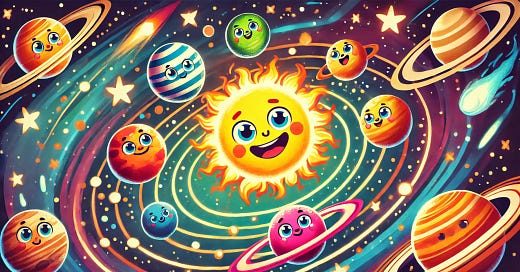How Do Planets Stay in Their Orbit?
Imagine throwing a ball to your friend in the park. When you throw it, the ball goes forward, but if you don’t catch it, it will fall to the ground. Now, what if there was no ground, and your ball just kept going forever? That might sound a little like magic, but it’s not—it’s science! This is similar to how planets stay in their orbits around the Sun, and we’re going to explore exactly how that works.
Hello my friends!
For a quick note, welcome to Tidbits with Titus, a podcast and newsletter where we tackle the big, curious questions kids ask every day in fun, bite-sized ways! I’m Alexander Titus, but I go by Titus. I’m a scientist, adventurer, and a huge fan of making science, technology, and life accessible to all ages. From “How does electricity work?” to “What are taxes?” and even “Why is the sky blue?” I’m here to dive into these wonder-filled questions with engaging stories and simple explanations that spark curiosity and make learning a joy. This effort is all about creating a space where families can learn together, discover the magic of the every day, and find thoughtful ways to explore the world’s big mysteries. Let’s make curiosity a family tradition—one tidbit at a time!
Just so you know, these podcast episodes are all AI-generated using Google’s really cool NotebookLM technology. That means there are some errors in how words are said, but that is part of the fun!
If your little ones have questions that you want help answering, shoot me an email at questions@tidbitswithtitus.com and I’ll see what I can do!
You can subscribe to the newsletter that has this information as well at tidbitswithtitus.com.
Also please share with anyone you think would be interested. The more the merrier!
Cheers,
-Titus
What Is an Orbit?
An orbit is like an invisible racetrack in space. Planets, moons, and other objects travel along these paths as they move around larger objects, like the Sun or a planet. But why do they stay on this invisible track and not just float away?
It all comes down to two important forces: gravity and motion. Let’s take a closer look at these forces and how they work together to create orbits.
Gravity: The Pulling Power of the Universe
Have you ever noticed how things fall to the ground when you drop them? That’s because of gravity. Gravity is a force that pulls things toward each other. On Earth, gravity keeps us on the ground and makes balls, apples, and even rain fall down.
The Sun, which is much bigger than Earth, has a very strong gravitational pull. It pulls on all the planets in our solar system, just like Earth pulls on everything near it. This is why planets like Mercury, Venus, Earth, and Mars don’t float away into space—they are being held in place by the Sun’s gravity.
Motion: The Speed to Stay in Orbit
If gravity were the only force at work, all the planets would just crash into the Sun! But they don’t. That’s because planets are also moving forward very fast. Imagine spinning a ball tied to a string around your head. If you let go of the string, the ball would fly off in a straight line. This forward motion is called inertia.
Planets work in a similar way. They are moving forward, but the Sun’s gravity pulls them inward, creating a balance. This balance keeps the planets moving in a circle or oval-shaped path around the Sun instead of flying off into space or falling into the Sun.
A Perfect Balance: Gravity and Motion
Let’s put it all together! Planets stay in their orbits because of the perfect balance between gravity and motion. Gravity pulls the planet toward the Sun, while the planet’s forward motion tries to pull it away. These two forces work together like a tug-of-war, creating a steady path around the Sun.
Here’s a fun way to imagine it: think of a roller coaster. The tracks guide the cars as they zip around, up, and down. Orbits are like invisible roller coaster tracks for planets, but instead of tracks, gravity and motion keep them on course.
Do All Planets Have the Same Orbit?
Not all planets have the same type of orbit. Some planets, like Earth, travel in almost perfect circles around the Sun. Others, like Pluto (which is now called a dwarf planet), have orbits that are more stretched out, like an oval. These shapes are called ellipses.
The time it takes for a planet to complete one trip around the Sun is called a year. For Earth, that’s 365 days. But for planets farther from the Sun, like Neptune, a year can last much longer because they have bigger orbits.
What About Moons?
Planets aren’t the only things with orbits. Many planets have moons, and these moons orbit the planets! For example, Earth has one moon, but Jupiter has over 90! Just like planets are held in orbit by the Sun’s gravity, moons are held in orbit by the gravity of their planet.
Other Cool Orbits in Space
Asteroids and Comets: These space rocks and icy travelers also have orbits. Comets, like Halley’s Comet, have very long orbits that take them far from the Sun and then back close again.
Satellites: Did you know that people have put objects in orbit too? Satellites are machines we send into space to circle Earth. They help us with things like weather forecasts, TV signals, and even talking on the phone!
What If Gravity Disappeared?
Gravity is very important. Without it, planets wouldn’t stay in their orbits. They would just fly off into space! The Sun’s gravity keeps the solar system organized, like a teacher guiding students in a line. It’s what makes life on Earth possible by keeping us the perfect distance from the Sun—not too hot and not too cold.
Fun Facts About Orbits
The Fastest Planet: Mercury, the closest planet to the Sun, moves the fastest in its orbit. It takes just 88 days to go around the Sun!
The Slowest Planet: Neptune, the farthest planet from the Sun, takes about 165 years to complete one orbit.
Earth’s Speed: Earth orbits the Sun at a speed of about 67,000 miles per hour. That’s faster than a race car!
How Do Scientists Study Orbits?
Astronomers use telescopes to study how planets and moons move. They also use math to calculate the forces at work. In fact, a famous scientist named Isaac Newton came up with the idea of gravity to explain why objects fall and why planets orbit the Sun.
Can We See Orbits?
You can’t see orbits because they’re invisible, but you can see the effects of orbits. When you watch the Moon rise or look at the stars moving across the sky at night, you’re seeing objects in orbit. Even the seasons are caused by Earth’s orbit around the Sun!
Let’s Review
Planets stay in their orbits because of:
Gravity: The pulling force of the Sun.
Motion: The forward speed of the planets.
Together, these forces create a perfect balance that keeps planets, moons, and other objects moving along their invisible tracks in space. Isn’t it amazing how the universe works?
Explore at Home
Want to see how orbits work? Try this fun experiment:
Tie a small ball to a piece of string.
Swing the ball around your head in a circle.
Feel the pull of the string—that’s like gravity!
If you let go of the string, the ball will fly off in a straight line. This is how motion works in space without gravity.
Now you know how planets stay in their orbits! The next time you look up at the sky, you can imagine all the planets, moons, and stars working together in an amazing cosmic dance. Isn’t science cool? 🌟














Share this post